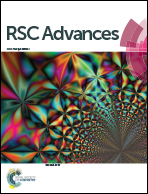De novo design of stereochemically-bent sixteen-residue β-hairpin as a hydrolase mimic†
Abstract
De novo design is a powerful tool to explore principles of protein folding and function. Design of enzymes is a formidable challenge: a designed polypeptide must fold to bind the desired guest, catalyze the desired reaction, release the product formed, and accomplish all the effects simultaneously. Here we describe design of a stereochemically-bent sixteen-residue β-hairpin polypeptide as a hydrolase mimic. The enzyme is accomplished to the desired specificity in two steps; first main chain is organized as the desired fold, and then sequences are optimized to the desired specificity as enzymes. The fold is designed stereochemically and the enzyme is achieved chemically: stereochemical modification of a canonical poly-L β-hairpin furnishes the desired fold which is optimized to the desired sequence specificity as an enzyme. The optimization of sequence implemented by inverse design is targeted for having the desired fold programmed as the desired enzyme chemically. Distinct side chains defining the desired active site are reshuffled to have their roles in stabilizing the targeted enzyme and in specifying it as a catalyst tested. The designed sequences of heterochiral structure are synthesized and are assessed for substrate binding by fluorescence and for enzymatic activity with UV-based kinetic assays. We report success in achieving hydrolases in sixteen-residue polypeptides with application of p-nitrophenyl acetate as the model substrate. The enzyme mimics, even while modest in activity, are remarkable in their short sequence length relative to natural enzymes, which are constrained to be long polypeptides and homochirality of poly-L structures could be a reason. The study thus underscores the value stereochemistry offers for having novel folds fashioned, and the value stepwise algorithm offers to have the folds of desired function specificity programmed chemically.



 Please wait while we load your content...
Please wait while we load your content...